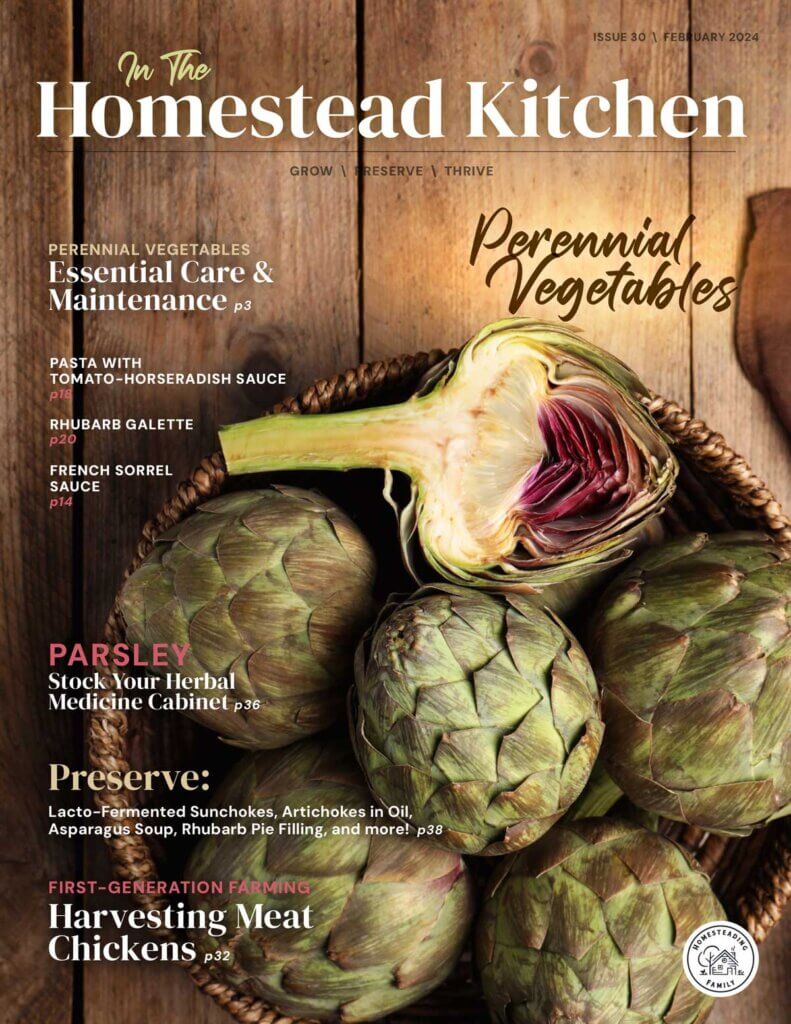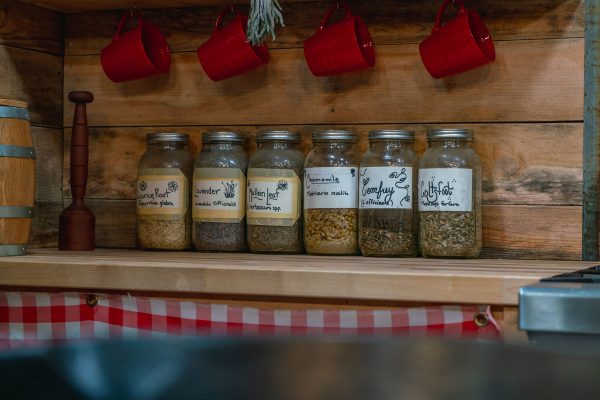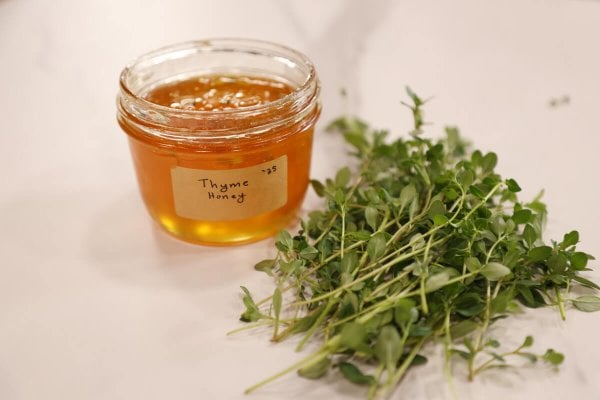This easy-to-make asparagus soup is both hearty and healthy, making it the perfect choice for any meal. Whether you’re a seasoned cook or a beginner in the kitchen, this recipe is sure to impress.

Table of Contents
ToggleWhy I Love Asparagus Soup
Asparagus soup is a delightful combination of fresh asparagus, creamy textures, and flavorful herbs. The earthy taste of asparagus blends perfectly with the richness of homemade bone broth, creating a harmonious balance that will leave your taste buds craving for more. Not only is it incredibly tasty, but it’s also a great way to add more greens to your diet.
Asparagus season always feels too short for me. Roasted asparagus, asparagus frittata, pickled asparagus, and asparagus soup (a household favorite) are all dishes I want to eat year-round.
While I can’t control the growing season, I can put up many of the dishes I love to eat out of season. Asparagus soup and my easy tomato soup recipe are the perfect examples! They pressure can beautifully, and opening a jar for lunch feels like stepping right back into spring and summer. Paired with my no-knead five-minute artisan bread, you’re in for one special meal.
What’s even better, asparagus soup can be used as a base for casseroles, other soups, or anywhere you would use a cream soup.

What Does Asparagus Soup Taste Like?
Asparagus soup has a rich asparagus flavor. If you don’t care for asparagus, this recipe may be one to pass up. The taste of asparagus soup can be described as earthy, grassy, and subtly sweet. If you’ve never tasted home-grown asparagus plucked and eaten straight from the garden, you’ve truly never tasted asparagus!
When cooked properly, asparagus soup has a smooth and creamy texture that adds depth to the overall taste. The soup is often seasoned with aromatics like onions, garlic, and herbs, which further enhance the flavor profile and provide a fantastic way to incorporate this nutritious vegetable into your diet.

What Can I Do With the Tough Part of Asparagus?
Asparagus is a versatile and delicious vegetable, but sometimes the tough fibrous ends can be off-putting. However, there are several creative ways to repurpose the tough part of asparagus and reduce food waste.
- Vegetable Stock – By simmering the ends along with other vegetable scraps like onion peels and carrot tops, you can create a flavorful stock that can be used as a base for soups, stews, and other dishes.
- Asparagus Broth – Another option is to make a flavorful asparagus broth. Boil the tough ends in water with some aromatics like garlic and herbs to infuse the liquid with a savory asparagus flavor. This broth can be used as a base for risotto, couscous, or any dish that benefits from a boost of asparagus taste.
- Asparagus Puree – If you prefer a smooth texture in your dishes, you can turn the tough asparagus ends into a delicious puree. Simply trim off the woody parts, blanch them, and then puree them until smooth. This puree can be used as a sauce or a flavor-packed addition to dips, spreads, or mashed potatoes.
- Bacon – One of our favorite things to do is to turn our kitchen scraps into bacon. How do we do this? By feeding them to the pigs, of course! When you know your kitchen scraps are going to good use, it’s easier to let them go without feeling wasteful.
- Composting – If you make compost at home, you can simply chop up the tough asparagus ends and add them to your compost. Asparagus ends are rich in nutrients and will contribute to the overall health of your compost, creating nutrient-rich soil for your garden.

Asparagus Soup Serving Suggestions
When it comes to serving asparagus soup, the possibilities are endless. Here are some creative suggestions to elevate your dining experience:
- Garnish with Fresh Herbs – Sprinkle some freshly chopped parsley, chives, or dill on top of your asparagus soup to add a burst of flavor and a touch of vibrant green.
- Croutons – Toasted croutons add a delightful crunch to every spoonful. You can make your own by cubing day-old bread (try this easy 5-minute no-knead bread recipe), tossing it with olive oil and seasoning, and baking until golden brown.
- Grated Parmesan Cheese – A generous sprinkle of grated Parmesan cheese on top of your hot asparagus soup adds a rich, savory and slightly salty element to the dish.
- Sour Cream or Yogurt – Drizzle a dollop of sour cream or this Instant Pot yogurt on top of your asparagus soup for a creamy and tangy contrast.
- Crumbled Bacon – Who doesn’t love home-cured bacon? For a touch of indulgence, crumble some crispy bacon over your asparagus soup. The smoky and salty flavors pair perfectly with the earthy taste of asparagus.

Tips for the Best Asparagus Soup
Creating a creamy and delicious asparagus soup requires a few tips and tricks to ensure the best flavor and texture. Follow these guidelines to elevate your asparagus soup to the next level:
- Choose Fresh Asparagus – To make the best asparagus soup, start with fresh asparagus. Look for vibrant green stalks with firm stems and tight tips. Avoid any wilted or slimy asparagus, as that will affect the taste and quality of your soup.
- Trim and Prep Properly – Before using asparagus in your soup, it’s essential to trim off the tough ends. Simply hold the asparagus spear near the bottom and bend it until it naturally snaps. This ensures that you’re using the tender part of the vegetable, resulting in a smoother texture.
- Sauté for Extra Flavor – Before adding the asparagus to your soup, sauté it with onions and garlic in some butter or olive oil. This step enhances the depth of flavor and adds complexity to the soup.
- Add Cream or Dairy – For an extra creamy and rich texture, consider adding heavy cream, milk, or your preferred dairy product to the soup. This adds lusciousness and smoothness, elevating the overall taste.
- Season Generously – Don’t be afraid to season your asparagus soup with salt, pepper, and other herbs and spices. As asparagus can have a subtle flavor, proper seasoning is key to bringing out its best taste. Experiment with different seasonings to find your favorite combination.
- Blend Well – To achieve a velvety and smooth consistency, use a blender or immersion blender to puree the soup. This will help incorporate all the flavors and create a cohesive texture.
- Garnish and Serve with Care – When serving your asparagus soup, consider garnishing it with fresh herbs, drizzles of olive oil, croutons, chopped asparagus tops, or a dollop of sour cream. These finishing touches add visual appeal and add another layer of flavor to the dish.

The Homestead Kitchen
This asparagus soup recipe was featured in issue No.30 of the Homestead Kitchen magazine. If you desire a life of self-reliance but find yourself scrolling through social media, watching the lives of others who are fulfilling YOUR dream, then this magazine was designed just for you.
Our goal as established homesteaders is to share all we have learned, both the good and bad, to support you and help you build the confidence you need to chase your homesteading dreams.
Enter the Homestead Kitchen magazine. This beautiful, well-designed magazine, curated with homesteading information like recipes, DIY instructions, tips and tricks, and easy-to-follow guides, will save you time and headaches on your homesteading journey.
The response has been so great that this magazine is now available in print! So subscribe today to have your monthly copy delivered right to your mailbox.

Supplies Needed
Before making your delicious creamy asparagus soup, make sure you have all the necessary supplies at hand. Here’s a list of essentials you’ll need:
- Large Stockpot – This recipe makes 12-16 servings. If scaled down, a saucepan or enameled Dutch oven can also be used.
- Immersion Blender – A high-powered blender can also be used. Just be careful to allow the soup to cool and properly vent the blender so that pressure does not build up, causing the lid to fly off.
- Cutting Board – Save your beautiful countertops from damage!
- Sharp Knife – Understanding knife sharpening basics is essential for every homesteading kitchen.
- Wooden Spoon or Spatula – I love using these wooden spoons and this silicone spatula in my kitchen.

Ingredients
For this delicious and creamy asparagus soup recipe, you’ll need the following ingredients:
- 1 Tbsp Butter – Learn how to make butter at home here.
- 2 Small Sweet Onions, Diced – If you grow your own onions, you can learn how to grow onions from seed and the best way to store onions for long-term storage.
- 3 Garlic Cloves, Minced – Freeze-dried garlic also works great!
- 5 lbs Fresh Asparagus, Ends Trimmed – Don’t toss your ends! Use one of the clever suggestions mentioned above to use up these tough ends.
- 12 cups Chicken Broth – Homemade bone broth is best. It will result in a better texture and mouthfeel than using store-bought broth.
- 1 tsp Salt – We like using a high-quality salt such as Redmond Real Salt (use coupon code “HFSalt” at checkout for 15% off your order).
- ¼ tsp Ground Black Pepper – Use more or less to taste.



How to Make Asparagus Soup
- Cut asparagus spears into 1-inch pieces.
- In a large stockpot, melt the butter.
- Add onion and sauté until translucent.
- Add asparagus, salt, and pepper, and cook, stirring frequently, for 8-10 minutes until asparagus begins to soften.
- Add garlic, stir, and cook one minute more.
- Add chicken broth and bring the soup to a boil.
- Once the soup boils, reduce to a simmer and cook for half an hour.
- Blend soup with an immersion blender (or carefully in batches in a blender) until completely smooth.
- Add optional toppings and serve immediately.

Storing Asparagus Soup
Once you’ve made a delicious batch of asparagus soup, you may find yourself with leftovers. Putting up your extra soup is a great way to make sure you have a convenient and ready-to-eat homemade meal on hand for those busy days.
How Long Does Asparagus Soup Last in the Fridge?
Typically, homemade asparagus soup can be safely stored in the refrigerator for up to 3-4 days. It is crucial to allow the soup to cool completely before transferring it to an airtight container or airtight food storage bag. This will help prevent the growth of bacteria and the formation of unpleasant odors.
Freezing Asparagus Soup
For longer storage, you may opt to freeze your asparagus soup. Freezing can extend the shelf life of the soup for up to 3 months.
- Allow the soup to cool completely before freezing. This will prevent condensation from forming inside the storage container and affecting the quality of the soup.
- Select freezer-safe containers or resealable plastic bags that are suitable for storing liquids. Make sure the containers are airtight and leak-proof to prevent freezer burn and maintain the flavor of the soup.
- Divide the soup into individual or family-sized portions, depending on your needs. This will make it easier to defrost and reheat the soup later on.
- Don’t forget to label each container with the name and date. This will help you keep track of when the soup was frozen and ensure you use it within the recommended time frame.
- Place the containers of soup in the freezer, making sure to leave some space for expansion. Store the soup in a part of the freezer where it won’t be disturbed, such as the back or bottom, to maintain its quality.
- To defrost and reheat the frozen asparagus soup, simply transfer the portion you want to use into the refrigerator and allow it to thaw overnight. Once thawed, heat the soup in a saucepan over medium heat until it reaches your desired temperature. Give it a good stir to promote even heating, and enjoy!

Canning Asparagus Soup
- Wash your jars, lids, and rings in hot, soapy water.
- Fill the pressure canner with 2-3 inches of water and put it on the stove on a low heat to warm.
- Put a little water in the clean jars to keep them weighed down, and place them in the canner.
- Turn the canner off when it begins to steam to keep the jars warm.
- Prepare your preserve according to the directions above.
- Remove the hot jars from the canner and turn the canner on again to bring the water to a low simmer (180°F).
- Use a funnel to fill the jars, leaving 1 inch of headspace. Release the bubbles, adding more liquid if needed.
- Clean the rims of the jars with a vinegar-soaked towel and gently screw on the lids to fingertip tight.
- Carefully place the jars into the pressure canner.
- Place the lid on the pressure canner and turn up the heat.
- Let the steam vent for 10 minutes.
- Put the pressure regulator on the lid.
- Bring the canner to 11 PSI on a dial gauge or 10 PSI for a weighted gauge (adjust for elevation).
- Once your canner has stabilized at full pressure, set a timer for 60 minutes for pint jars (75 minutes for quarts).
- Turn off the heat, then let the canner come down to 0 PSI by itself.
- Remove the pressure regulator and let the canner stabilize for 5 minutes before removing the lid.
- Carefully take the lid off the canner.
- Remove the jars and set them on a clean towel where they can cool undisturbed for 16-24 hours.
- Check Seals and Clean Jars: Check each seal, remove the bands and clean each jar with room-temperature water, if needed
- Label each jar with the contents and year.
- Store the jars out of direct sunlight.
Asparagus soup is a true comfort food. Its creamy texture and delicate taste create a sense of warmth and coziness, perfect for those chilly evenings in the homestead kitchen. Whether enjoyed as an appetizer or a main course, this hearty soup satisfies both the body and the spirit.
Did you make this recipe? If so, please leave a star rating in the recipe card below. Then, snap a photo and tag us on social media @homesteadingfamily so we can see your soup!

FAQ
Asparagus soup has a delicate and slightly earthy flavor. It’s fresh, aromatic, and subtly sweet, with a hint of nuttiness. The creaminess of the soup adds richness and smoothness to the overall taste.
The tough part of asparagus can be used in various ways. You can save it to make vegetable broth or stock, which adds a wonderful depth of flavor to soups and sauces. Another option is to finely chop it and incorporate it into dishes like frittatas, stir-fries, or quiches, where it will soften and blend in with other ingredients.
Asparagus soup can be stored in the refrigerator for up to 3-4 days. Make sure to transfer it to an airtight container or cover it tightly with plastic wrap to maintain its freshness. When reheating, heat it gently over low heat to prevent curdling or separation.
Asparagus soup pairs well with various garnishes and accompaniments. Some popular choices include fresh herbs like chives or dill, a drizzle of olive oil or truffle oil for added richness, a sprinkle of grated Parmesan cheese or croutons for texture, or even a dollop of sour cream or Greek yogurt for a tangy touch. Serve it alongside crusty bread or a grilled cheese sandwich for a satisfying meal.
To make the best asparagus soup, make sure that you use fresh and tender asparagus stalks. Trim off any tough ends and peel the outer layer if necessary. Sautéing the asparagus with onions or leeks before adding the liquid can enhance the flavors. Use a high-quality chicken broth or vegetable broth for a rich base. Use an immersion blender or a regular blender to achieve a smooth and creamy consistency. Season with salt and pepper to taste, and consider adding a splash of fresh lemon juice or a sprinkle of fresh herbs like parsley or thyme for a burst of freshness.
To freeze asparagus soup, allow it to cool completely. Transfer the soup to freezer-safe containers or resealable plastic bags, leaving some room for expansion. Label the containers with the date and contents. Store the soup in the freezer for up to 3 months. When ready to use, thaw it overnight in the refrigerator and reheat gently on the stovetop, adding a little extra cream or broth if desired.
Other Posts You May Enjoy
- Quick and Hearty Easy Tomato Soup Recipe
- Easy Soup (aka Pantry Soup) for Quick Weeknight Meals
- Cream of Chicken Soup Recipe (Or ANY Cream of Soup Recipe)
- Bread Soup – A Quick and Easy Lunch
- Instant Pot Chicken Bone Broth (That Gels Every Time)
- How to Can Beef Stew for Easy Convenience Meals
- Easy White Bean Chicken Chili – Pressure Canning Recipe

Asparagus Soup
Equipment
- Large Stockpot
- Immersion Blender or blender
- cutting board
- sharp knife
- wooden spoon or spatula
- Pressure Canner optional
Ingredients
- 1 Tablespoon butter
- 2 small sweet onions
- 3 cloves garlic minced
- 5 pounds asparagus trimmed
- 12 cups chicken broth
- 1 teaspoon salt
- 1/4 teaspoon ground black pepper
Instructions
Cooking Instructions
- Cut asparagus spears into 1-inch pieces.
- In a large stockpot, melt the butter.
- Add onion and sauté until translucent.
- Add asparagus, salt, and pepper, and cook, stirring frequently, for 8-10 minutes until asparagus begins to soften.
- Add garlic, stir, and cook one minute more.
- Add chicken broth and bring the soup to a boil.
- Once the soup boils, reduce to a simmer and cook for half an hour.
- Blend soup with an immersion blender (or carefully in batches in a blender) until completely smooth.
- Add optional toppings and serve immediately.
Pressure Canning Instructions
- Prepare your jars, lids, rings, and canner.
- Wash your jars, lids, and rings in hot, soapy water.
- Fill the pressure canner with 2-3 inches of water and put it on the stove on a low heat to warm.
- Put a little water in the clean jars to keep them weighed down, and place them in the canner.
- Turn the canner off when it begins to steam to keep the jars warm.
- Fill jars, fit lids, and place in pressure canner.
- Remove the hot jars from the canner and turn the canner on again to bring the water to a low simmer (180°F).
- Use a funnel to fill the jars with asparagus soup, leaving 1 inch of headspace. Release the bubbles, adding more liquid if needed.
- Clean the rims of the jars with a vinegar-soaked towel and gently screw on the lids to fingertip tight.
- Carefully place the jars into the pressure canner.
- Place the lid on the pressure canner and turn up the heat.
- Let the steam vent for 10 minutes.
- Put the pressure regulator on the lid.
- Bring the canner to 11 PSI on a dial gauge or 10 PSI for a weighted gauge (adjust for elevation).
- Once your canner has stabilized at full pressure, set a timer for 60 minutes for pint jars (75 minutes for quarts).
- Turn off the heat, then let the canner come down to 0 PSI by itself.
- Remove the pressure regulator and let the canner stabilize for 5 minutes before removing the lid.
- Carefully take the lid off the canner.
- Remove the jars and set them on a clean towel where they can cool undisturbed for 16-24 hours.
- Check each seal, remove the bands and clean jars with room-temperature water, if needed.
- Label each jar with the contents and year.
- Store the jars out of direct sunlight.
Notes
- Add Cream or Dairy – For an extra creamy and rich texture, consider adding heavy cream, milk, or your preferred dairy product to the soup. This adds lusciousness and smoothness, elevating the overall taste.
Freezing Asparagus Soup
For longer storage, you may opt to freeze your asparagus soup. Freezing can extend the shelf life of the soup for up to 3 months.- Allow the soup to cool completely before freezing. This will prevent condensation from forming inside the storage container and affecting the quality of the soup.
- Select freezer-safe containers or resealable plastic bags that are suitable for storing liquids. Make sure the containers are airtight and leak-proof to prevent freezer burn and maintain the flavor of the soup.
- Divide the soup into individual or family-sized portions, depending on your needs. This will make it easier to defrost and reheat the soup later on.
- Don’t forget to label each container with the name and date. This will help you keep track of when the soup was frozen and ensure you use it within the recommended time frame.
- Place the containers of soup in the freezer, making sure to leave some space for expansion. Store the soup in a part of the freezer where it won’t be disturbed, such as the back or bottom, to maintain its quality.
- To defrost and reheat the frozen asparagus soup, simply transfer the portion you want to use into the refrigerator and allow it to thaw overnight. Once thawed, heat the soup in a saucepan over medium heat until it reaches your desired temperature. Give it a good stir to promote even heating, and enjoy!


















